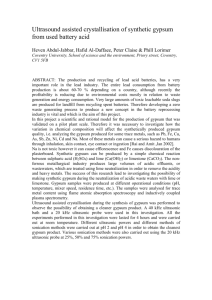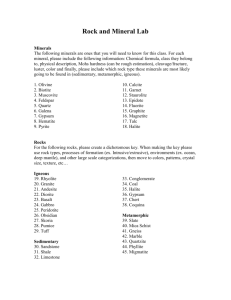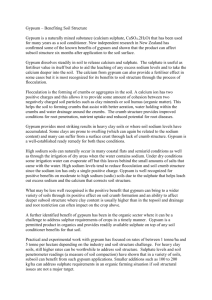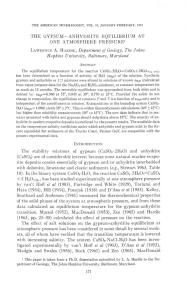Gypsum - International Plant Nutrition Institute
advertisement
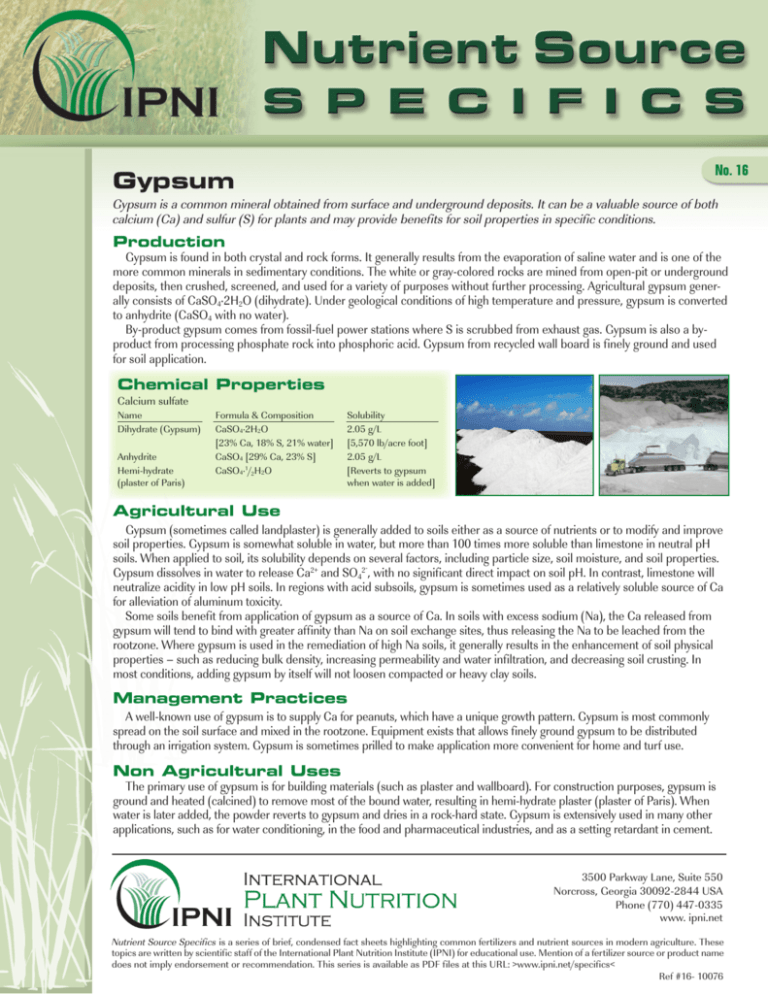
No. 16 Gypsum Gypsum is a common mineral obtained from surface and underground deposits. It can be a valuable source of both calcium (Ca) and sulfur (S) for plants and may provide benefits for soil properties in specific conditions. Production Gypsum is found in both crystal and rock forms. It generally results from the evaporation of saline water and is one of the more common minerals in sedimentary conditions. The white or gray-colored rocks are mined from open-pit or underground deposits, then crushed, screened, and used for a variety of purposes without further processing. Agricultural gypsum generally consists of CaSO4·2H2O (dihydrate). Under geological conditions of high temperature and pressure, gypsum is converted to anhydrite (CaSO4 with no water). By-product gypsum comes from fossil-fuel power stations where S is scrubbed from exhaust gas. Gypsum is also a byproduct from processing phosphate rock into phosphoric acid. Gypsum from recycled wall board is finely ground and used for soil application. Chemical Properties Calcium sulfate Name Formula & Composition Dihydrate (Gypsum) CaSO4·2H2O [23% Ca, 18% S, 21% water] Anhydrite CaSO4 [29% Ca, 23% S] Hemi-hydrate CaSO4·1/2H2O (plaster of Paris) Solubility 2.05 g/L [5,570 lb/acre foot] 2.05 g/L [Reverts to gypsum when water is added] Agricultural Use Gypsum (sometimes called landplaster) is generally added to soils either as a source of nutrients or to modify and improve soil properties. Gypsum is somewhat soluble in water, but more than 100 times more soluble than limestone in neutral pH soils. When applied to soil, its solubility depends on several factors, including particle size, soil moisture, and soil properties. Gypsum dissolves in water to release Ca2+ and SO42 , with no significant direct impact on soil pH. In contrast, limestone will neutralize acidity in low pH soils. In regions with acid subsoils, gypsum is sometimes used as a relatively soluble source of Ca for alleviation of aluminum toxicity. Some soils benefit from application of gypsum as a source of Ca. In soils with excess sodium (Na), the Ca released from gypsum will tend to bind with greater affinity than Na on soil exchange sites, thus releasing the Na to be leached from the rootzone. Where gypsum is used in the remediation of high Na soils, it generally results in the enhancement of soil physical properties – such as reducing bulk density, increasing permeability and water infiltration, and decreasing soil crusting. In most conditions, adding gypsum by itself will not loosen compacted or heavy clay soils. Management Practices A well-known use of gypsum is to supply Ca for peanuts, which have a unique growth pattern. Gypsum is most commonly spread on the soil surface and mixed in the rootzone. Equipment exists that allows finely ground gypsum to be distributed through an irrigation system. Gypsum is sometimes prilled to make application more convenient for home and turf use. Non Agricultural Uses The primary use of gypsum is for building materials (such as plaster and wallboard). For construction purposes, gypsum is ground and heated (calcined) to remove most of the bound water, resulting in hemi-hydrate plaster (plaster of Paris). When water is later added, the powder reverts to gypsum and dries in a rock-hard state. Gypsum is extensively used in many other applications, such as for water conditioning, in the food and pharmaceutical industries, and as a setting retardant in cement. 3500 Parkway Lane, Suite 550 Norcross, Georgia 30092-2844 USA Phone (770) 447-0335 www. ipni.net Nutrient Source Specifics is a series of brief, condensed fact sheets highlighting common fertilizers and nutrient sources in modern agriculture. These topics are written by scientific staff of the International Plant Nutrition Institute (IPNI) for educational use. Mention of a fertilizer source or product name does not imply endorsement or recommendation. This series is available as PDF files at this URL: >www.ipni.net/specifics< Ref #16- 10076

